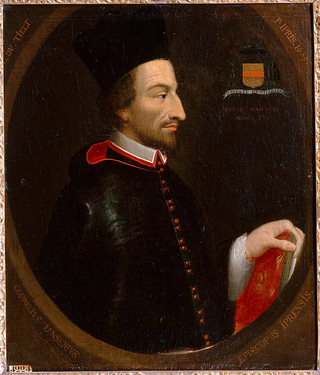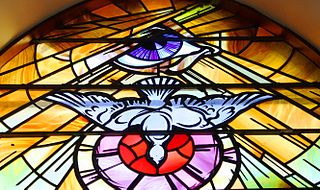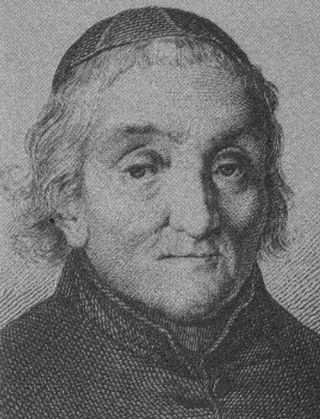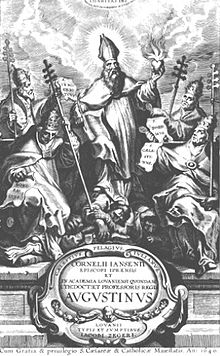
Jansenism was an early modern theological movement within Catholicism, primarily active in the Kingdom of France, that arose in an attempt to reconcile the theological concepts of free will and divine grace. Jansenists claimed to profess the true doctrine of grace as put forth by Augustine of Hippo. In 1653, Pope Innocent X promulgated the bull Cum occasione, which condemned five errors attributed to Jansenism, including the idea that Christ did not die or shed his blood for all men.

In Western Christian theology, grace is created by God who gives it as help to one because God desires one to have it, not necessarily because of anything one has done to earn it. It is understood by Western Christians to be a spontaneous gift from God to people – "generous, free and totally unexpected and undeserved" – that takes the form of divine favor, love, clemency, and a share in the divine life of God. In the Eastern Orthodox Church, grace is the uncreated Energies of God. Among Eastern Christians generally, grace is considered to be the partaking of the Divine Nature described in 2 Peter 1:4 and grace is the working of God himself, not a created substance of any kind that can be treated like a commodity.

Cornelius Jansen was the Dutch Catholic bishop of Ypres in Flanders and the father of a theological movement known as Jansenism.

Antoine Arnauld was a French Catholic theologian, philosopher and mathematician. He was one of the leading intellectuals of the Jansenist group of Port-Royal and had a very thorough knowledge of patristics. Contemporaries called him le Grand to distinguish him from his father.
Semi-Pelagianism is a Christian theological and soteriological school of thought about the role of free will in salvation. In semipelagian thought, a distinction is made between the beginning of faith and the increase of faith. Semi-Pelagian thought teaches that the latter half – growing in faith – is the work of God, while the beginning of faith is an act of free will, with grace supervening only later. Semi-Pelagianism in its original form was developed as a compromise between Pelagianism and the teaching of Church Fathers such as Saint Augustine. Adherents to Pelagianism hold that people are born untainted by sin and do not need salvation unless they choose to sin, a belief which had been dismissed as heresy. In contrast, Augustine taught that people cannot come to God without the grace of God. Like Pelagianism, Semipelagianism was labeled heresy by the Western Church at the Second Council of Orange in 529.

Louis Antoine de Noailles, Cardinal de Noailles, second son of Anne de Noailles, 1st Duke of Noailles, was a French bishop and cardinal. His signing of the Unigenitus bull in 1728 would end the formal Jansenist controversy.
Baianism is a term applied to the school of thought of Catholic theologian Michael Baius (1513-1589). Its foremost apologists, Baius among them, largely claimed this school and its teachings to be a return to a sort of Augustinianism, against the reliance on Scholasticism and Scholastic writings which held sway over most Catholic theologians at the time. It is the immediate historical predecessor of Jansenism, and, as with Jansenism, has been deemed heterodox by the Catholic Church.

The Lettres provinciales are a series of eighteen letters written by French philosopher and theologian Blaise Pascal under the pseudonym Louis de Montalte. Written in the midst of the formulary controversy between the Jansenists and the Jesuits, they are a defense of the Jansenist Antoine Arnauld from Port-Royal-des-Champs, a friend of Pascal who in 1656 was condemned by the Faculté de Théologie at the Sorbonne in Paris for views that were claimed to be heretical. The first letter is dated January 23, 1656 and the eighteenth March 24, 1657. A fragmentary nineteenth letter is frequently included with the other eighteen.
Ad sanctam beati Petri sedem is an apostolic constitution in the form of a papal bull promulgated by Pope Alexander VII in 1656 which judged the meaning and intention of Cornelius Jansen's words in Augustinus, and confirmed and renewed the condemnation in Cum occasione promulgated by Pope Innocent X in 1653 that five propositions found in Augustinus were heretical.

The Congregatio de Auxiliis was a commission established by Pope Clement VIII to settle a theological controversy regarding divine grace that had arisen between the Dominicans and the Jesuits towards the close of the sixteenth century. It was presided over for a time by Peter Lombard, Archbishop of Armagh.
The formulary controversy was a 17th- and 18th-century Jansenist refusal to confirm the Formula of Submission for the Jansenists on the part of a group of Catholic ecclesiastical personnel and teachers who did not accept the charge that their beliefs about the nature of man and grace were heretical as the Holy See declared. In the Kingdom of France, it pitted Jansenists against Jesuits. It gave rise to French theologian Blaise Pascal's Lettres provinciales, the condemnation of casuistry by the Holy See, and the dissolution of organised Jansenism.

Martin de Barcos (1600–1678), was a French Catholic priest and theologian of the Jansenist School.
Nicolas Cornet was a French Catholic theologian.
Henri de Saint-Ignace was a Belgian Carmelite theologian.
Vineam Domini Sabaoth is an apostolic constitution in the form of a papal bull promulgated by Pope Clement XI in 1705 which declared that "obediential silence" is not a satisfactory response to the Formula of Submission for the Jansenists.
The term dogmatic fact is employed in the teaching of the Catholic Church, to mean any fact connected with a dogma, wherein the application of the dogma is itself what constitutes, or more accurately canonizes, the fact.

The Old University of Leuven was established in 1425 with Faculties of Arts, Medicine, Law; however, the university did not have a Faculty of Theology initially. In 1426 a Faculty of Canon Law was added, and at that time both Law Faculties functioned together in one Collegium utriusque iuris.
Regiminis Apostolici is an apostolic constitution in the form of a papal bull promulgated by Pope Alexander VII in 1665 which required, according to the Enchiridion symbolorum, "all ecclesiastical personnel and teachers" to subscribe to an included formulary, the Formula of Submission for the Jansenists:
I, N., submit to the apostolic constitution of the Supreme Pontiff Innocent X dated May 31, 1653, and to the constitution of the Supreme Pontiff Alexander VII dated October 16, 1656, and, with a sincere heart, I reject and condemn the five propositions taken from the book of Cornelius Jansen entitled Augustinus and in the sense understood by that same author, just as the Apostolic See has condemned them by the two above-mentioned constitutions, and I so swear: So help me God, and these holy Gospels of God.
Cum occasione is an apostolic constitution in the form of a papal bull promulgated by Pope Innocent X in 1653 which condemned five propositions said to have been found in Cornelius Jansen's Augustinus as heretical.

Pietro Tamburini was an Italian theologian and jurist. He openly espoused Jansenism as a university professor.









